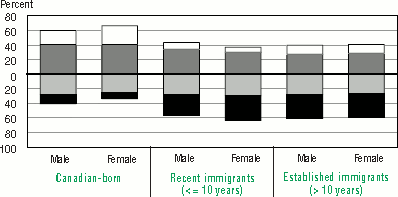
Figure 3.15 allows one to take a look at the distribution of prose literacy scores for immigrant and Canadian-born males and females. Thirty-four percent of recent female immigrants are at Level 1 – compared to nine percent for Canadian-born females. Similarly, a smaller proportion of recent immigrant females attain the highest levels of literacy, with only seven percent at Level 4/5 compared to 25 percent of Canadian-born women. Similarly, some 28 percent of recent male immigrants are at Level 1 literacy, a proportion more than double that of Canadian-born men. About nine percent of recent immigrant males compared to 19 percent of Canadian-born men are at Levels 4/5.
Figure 3.15
Source: International Adult Literacy and Skills Survey, 2003.
As the source countries from which immigrants come to Canada have changed in the recent decades, fewer immigrants report having English or French as their mother tongue than those who arrived earlier. In 2003, one in ten immigrants spoke English or French as a mother tongue, compared to almost one in three in 1980 (CIC, 2004). A key question is whether having a language other than English or French as a mother tongue is associated with literacy performance.
While the number of immigrants surveyed does not support an analysis of recent and established immigrants separately with respect to mother tongue, it is possible to examine all immigrant groups together in order to determine whether mother tongue affects literacy scores. Indeed, immigrants whose mother tongue is a language other than English or French have lower scores in all four domains (See Annex A Table 3.26).
Though immigrants whose mother tongue is English or French have lower average prose literacy scores than their Canadian-born counterparts, their performance is significantly higher than immigrants whose mother tongues are neither English nor French.